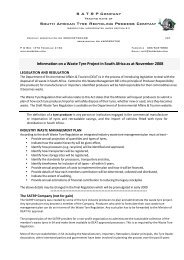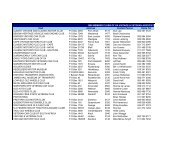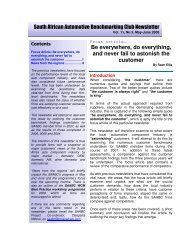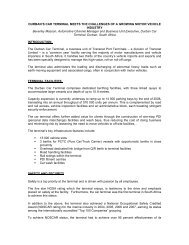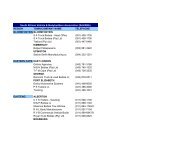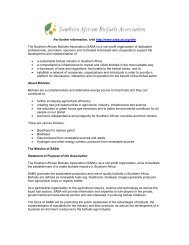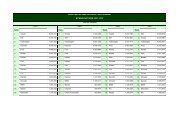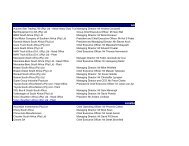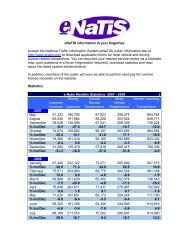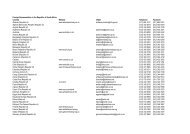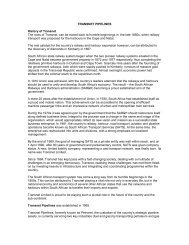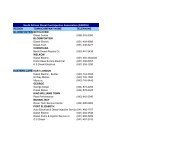Toyota South Africa Sustainability Report 2008 - Automotiveonline ...
Toyota South Africa Sustainability Report 2008 - Automotiveonline ...
Toyota South Africa Sustainability Report 2008 - Automotiveonline ...
You also want an ePaper? Increase the reach of your titles
YUMPU automatically turns print PDFs into web optimized ePapers that Google loves.
<strong>Sustainability</strong> <strong>Report</strong>_14-10-<strong>2008</strong>:Layout 1 10/14/08 2:46 PM Page 51<br />
G3 Index<br />
G3 Ref<br />
Pages<br />
G3 Ref<br />
Pages<br />
Aspect: Emissions, Effluents, and Waste<br />
EN16 Total direct and indirect greenhouse gas emissions by weight<br />
EN17 Other relevant indirect greenhouse gas emissions by weight<br />
EN18 Initiatives to reduce greenhouse gas emissions and reductions achieved<br />
EN19 Emissions of ozone-depleting substances by weight<br />
EN20 NO, SO, and other significant air emissions by type and weight<br />
EN21 Total water discharge by quality and destination<br />
EN22 Total weight of waste by type and disposal method<br />
EN23 Total number and volume of significant spills<br />
EN24 Weight of transported, imported, exported, or treated waste deemed hazardous<br />
under the terms of the Basel Convention Annex I, II, III, and VIII, and percentage of<br />
transported waste shipped internationally<br />
EN25 Identity, size, protected status, and biodiversity value of water bodies and related<br />
habitats significantly affected by the reporting<br />
EN26 Initiatives to mitigate environmental impacts of products and services, and extent<br />
of impact mitigation<br />
EN27 Percentage of products sold and their packaging materials that are reclaimed by category 16<br />
Aspect: Compliance<br />
EN28 Monetary value of significant fines and total number of non-monetary<br />
sanctions for non-compliance with environmental laws and regulations<br />
Aspect: Transport<br />
EN29 Significant environmental impacts of transporting products and other goods and<br />
materials used for the organisation operations, and transporting members of the<br />
workforce<br />
Aspect: Overall<br />
EN30 Total environmental protection expenditures and investments by type<br />
Social Performance Indicators<br />
LA1<br />
LA2<br />
LA3<br />
Labour Practices and Decent Work Performance Indicators<br />
Aspect: Employment<br />
Total workforce by employment type, employment contract, and region<br />
Total number and rate of employee turnover by age group, gender, and region<br />
Benefits provided to full-time employees that are not provided to temporary or<br />
part-time employees, by major operations<br />
13<br />
18<br />
12-15<br />
18<br />
18<br />
not<br />
reported<br />
16-17<br />
12<br />
17<br />
19<br />
20-22<br />
10, 12<br />
15<br />
22<br />
3, 33, 47<br />
34<br />
35<br />
LA4<br />
LA5<br />
LA6<br />
LA7<br />
LA8<br />
LA9<br />
Aspect: Labor/Management Relations<br />
Percentage of employees covered by collective bargaining agreements<br />
Minimum notice period(s) regarding operational changes, including whether it is<br />
specified in collective agreements<br />
Aspect: Occupational Health and Safety<br />
Percentage of total workforce represented in formal joint management–worker<br />
health and safety committees that help monitor and advise on occupational<br />
health and safety programs<br />
Rates of injury, occupational diseases, lost days, and absenteeism, and number of<br />
work related fatalities by region<br />
Education, training, counselling, prevention, and risk-control programs in place to<br />
assist workforce members, their families, or community members regarding serious<br />
diseases<br />
Health and safety topics covered in formal agreements with trade unions<br />
Aspect: Training and Education<br />
LA10 Average hours of training per year per employee by employee category<br />
LA11<br />
LA12<br />
LA13<br />
Programs for skills management and lifelong learning that support the<br />
continued employability of employees and assist them in managing career endings<br />
Percentage of employees receiving regular performance and career development<br />
reviews<br />
Aspect: Diversity and Equal Opportunity<br />
Composition of governance bodies and breakdown of employees per category<br />
according to gender, age group, minority group membership, and other indicators of<br />
diversity<br />
LA14 Ratio of basic salary of men to women by employee category<br />
Human Rights Performance Indicators<br />
HR1<br />
HR2<br />
HR3<br />
Aspect: Investment and Procurement Practices<br />
Percentage and total number of significant investment agreements that include<br />
human rights clauses or that have undergone human rights screening<br />
Percentage and total number of significant investment agreements that include<br />
human rights clauses or that have undergone human rights screening<br />
Total hours of employee training on policies and procedures concerning aspects of human 32<br />
rights that are relevant to operations, including the percentage of employees trained<br />
35<br />
data unavailable<br />
data unavailable<br />
35-39<br />
35-37<br />
data unavailable<br />
32<br />
32<br />
35<br />
33-35<br />
35<br />
data unavailable<br />
data unavailable<br />
<strong>Sustainability</strong> <strong>Report</strong> <strong>2008</strong> 51



